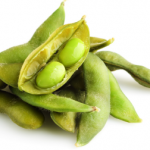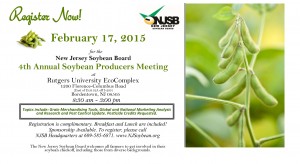New Jersey Soybean Board 4th Annual Soybean Producers Meeting
Date: February 17, 2015 8:30am to 3pm
Location: Rutgers University EcoComplex
1200 Florence-Columbus Road, Bordertown, NJTopics include: Grain Merchandising Tools, Global and National Marketing Analysis, plus, Research and Pest Control Update.
Pesticide Credits Requested.Registration is complimentary. Breakfast and Lunch are included.
To register, please call NJSB Headquarters 609-585-6871
www.NJSoybean.org
Annual Soybean Producers Meeting
Pesticide Storage Inventory Due May 1
All NJ licensed pesticide applicators, as well as dealers, who store pesticides are required by law to send a copy of their storage inventories with an explanatory cover letter to the local fire company by May 1st each year. [Read more…]
Statewide Soybean Meeting February 19, 2014
Date: February 19, 2014 9am to 3pm
Location: Elmer Grange, 535 Daretown Rd, Elmer, NJ
 The 3rd annual Soybean Producers meeting will be held on February 19 from 9:00am to 3:00pm at the Elmer Grange at 535 Daretown Road, Elmer, NJ. Topics will include the new High Oleic Acid Soybeans, GMO Labeling, Biodiesel Update, and various pest management updates including the newly found Palmer Amaranth in NJ.
The 3rd annual Soybean Producers meeting will be held on February 19 from 9:00am to 3:00pm at the Elmer Grange at 535 Daretown Road, Elmer, NJ. Topics will include the new High Oleic Acid Soybeans, GMO Labeling, Biodiesel Update, and various pest management updates including the newly found Palmer Amaranth in NJ.
Breakfast and Lunch provided.
Application for Pesticide Credits has been made.
Call 609-585-6871 to register.
[Read more…]
Stink Bugs in Soybean
Stink Bugs, including the Brown Marmorated type (BMSB), have begun to show up in soybean fields around the state.
The Plant Management Network has developed a webcast titled “Impact and Management of BMSB in Mid-Atlantic Soybean”.
This talk by Virginia Tech entomology professor Ames Herbert Jr., covers:
- Patterns of field infestation by BMSB;
- Conditions that may predispose soybean fields to infestation;
- The impact of BMSB feeding on soybean seed and yield;
- Field management practices that have proven successful with growers; and
- Insecticide efficacy comparisons
Find the webcast at
http://www.plantmanagementnetwork.org/edcenter/seminars/soybean/BMSB/
This 20-minute presentation is open access through November 30, 2013. Viewers can also opt to see a 2-minute executive summary version of the presentation. This shorter executive summary version is permanently open access courtesy of the United Soybean Board and supported by your New Jersey Soybean Board.
Wheat Harvest and Storage
Wheat is being harvested, or is ready to be harvested, in a good portion of the state, but high temperatures, high humidity and predicted rain showers daily for the next week have the potential to cause problems.
Where large amounts of rain fall, getting combines into the field may be difficult. Where fields are passable, grain may be mature but high in moisture. It is important to get wheat out of the field quickly after the kernals have matured to avoid loss of yield, reduced quality and ultimately sprouting in the heads. Combines operate most efficiently and with less kernal damage when grain moisture is between 13-20%. If wheat is harvested much above 14% it needs to be dried relatively quickly to prevent sprouting in storage. Wheat is harder to dry than corn because of the high humidity this time of the year and because it packs tighter than corn thus grain depths in the bin need to shallower or fan speeds/volumes greater.
The following links to publications from Purdue University and the University of Missouri may be useful if the current weather conditions persist and problems are encountered.
Soybean Double Cropping

David Holshouser
VT
Increasing Double-Cropped Soybean Yield
http://www.plantmanagementnetwork.org/edcenter/seminars/soybean/DoubleCropped/
This 20-minute webcast is open access. Viewers can also opt to see a 5-minute executive summary version. This shorter executive summary version is permanently open access courtesy of the United Soybean Board. [Read more…]

